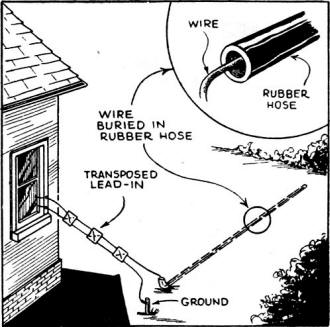|
February 1935 Short Wave Craft
 [Table
of Contents] [Table
of Contents]
Wax nostalgic about and learn from the history of early electronics. See articles
from Short Wave Craft,
published 1930 - 1936. All copyrights hereby acknowledged.
|
Burying any antenna in
the ground seems like a bad idea from radiated field pattern and efficiency perspectives.
As determined in a 1974 paper published by the
National Bureau of Standards, most of the energy from a buried dipole antenna
that is not absorbed by the ground is radiated nearly straight up (many studies
of underground antennas can be found). Motivating the NBS's burial study was a desire
to conceal radio communications antennas in covert operations. This short piece
in a 1935 edition of Short Wave Craft magazine reports on a case Hams were experimenting
with buried antennas in order to avoid the expense and trouble of an overhead installation.
These days, Hams want to bury antennas for those same reasons AND to get
around restrictive neighborhood and town restrictions prohibiting certain antenna
installations.
Update: RF Cafe visitor Jean-Marie Polard (F5VLB) sent me a note about his very
impressive Facebook page that contains a lot of information about
Earth Probes Used As Antennas.
Put Your Aerial Underground
|

Here's a clever way to try out an underground aerial for short-wave
reception, the wire being placed inside a length of garden hose and buried 2 feet
underground.
|
A well-known English radio writer, in a regular column in Amateur Wireless,
recently pointed out the possibilities of the underground aerial for short-wave
reception.
It appears that the writer was told about this type of collector, and tried it
by burying a 30-ft. length of garden hose through which a wire had been threaded,
2 feet deep.
The results were a somewhat lower signal strength, as compared to a good overhead
aerial, as might be expected. But, the noise-to-signal ratio was much improved,
especially with regard to such noises as passing automobiles and street cars.
Different lengths of buried wires were tried, but the original 30-ft. length
seemed to be the best length, as shorter wires reduced the pick-up too much, while
longer wires damped the set and prevented correct operation.
Posted August 14, 2024
(updated from original
post on 2/24/2015)
|










